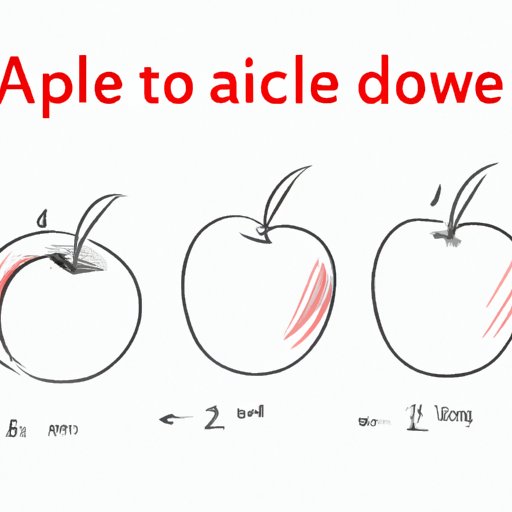Introduction
Drawing fruits like apples is a valuable skill for artists of all levels. It can add depth and dimension to your artwork, and serve as a great starting point for more complex compositions. In this article, we will provide you with step-by-step guidance, tips, and inspiration for drawing apples.
Step-by-Step Guide: How to Draw an Apple Like a Pro
Follow these easy-to-follow steps to draw an apple:
- Start by sketching a basic oval shape that’s wider at the bottom and narrower at the top. This will be the outline of your apple.
- Add a small rectangle or triangle shape at the top of the apple to represent the stem.
- Draw a leaf shape extending from the stem, using a series of short, curved lines.
- Use a darker pencil or pen to trace over the lines of your apple and stem, and erase any leftover guidelines.
- Shade the apple with a range of tones to add depth and dimension. Use a darker shade around the bottom and the stem, and gradually lighter shades as you move towards the top of the apple.
- Add highlights to the apple by using a white or light-colored pencil to lightly shade the top and sides of the apple, where the light would naturally hit it.
- For extra texture, you can cross-hatch or blend your shading to create a smoother or rougher surface.
You can repeat these steps for different types of apples, adjusting the shape and shading to match the specific variety you are drawing.
Explore Your Artistic Side: Drawing Apples for Beginners
If you are a beginner looking to improve your drawing skills, drawing apples is a great place to start. Here are some tips to help you get started:
- Find the right materials: Make sure you have good quality pencils, paper, and erasers to work with. Different types of pencils can produce different textures and effects, so experiment with different types to see what works best for you.
- Practice proportion and perspective: Pay attention to the size and placement of different elements of your apple, and use a reference image if needed. Learning to draw apples in proportion and perspective will help you with more complex compositions later on.
- Experiment with different styles and approaches: Don’t be afraid to try different styles and approaches to drawing apples. You can draw them realistically, in a whimsical or cartoon style, or in a minimalist or abstract way. Find what works best for you and have fun with it!
From Sketchbook to Masterpiece: Drawing Apples in Various Styles
Apples can be drawn in many different styles, each with its own unique look and feel. Here are some examples:
- Realistic: This style aims to capture the apple as closely as possible to its actual appearance, with shading and attention to detail. Famous artists who have depicted apples realistically include Paul Cézanne, William Henry Hunt, and Giorgio Morandi.
- Whimsical or Cartoon: In this style, apples are drawn in a playful and exaggerated manner, often with bright colors and bold outlines. You can see this style in children’s books, comics, and animation.
- Minimalist or Abstract: This style is all about simplicity, with minimal detail and a focus on shape and form. Examples include the iconic Apple logo, and the works of artists such as Ellsworth Kelly and Agnes Martin.
Experiment with different styles and approaches to find what works best for you, and don’t be afraid to mix and match styles to create your own unique look.
Fruitful Inspiration: Using Apples as a Reference for Drawing Still Life Scenes
Drawing apples can also be a starting point for creating more complex compositions, such as a fruit basket or a kitchen counter scene. Here are some tips for incorporating apples into larger scenes:
- Pay attention to lighting and shadow: Consider the light source in your scene, and use shading and highlighting to create a sense of depth and form. You can also experiment with different types of lighting, such as soft or harsh light.
- Composition and balance: Think about the placement and orientation of each apple in your scene, and how they interact with each other. You can use the rule of thirds to create a balanced and harmonious composition.
- The interplay between different fruits and objects: Adding other fruits or objects to your scene can create interesting contrasts and visual interest. Experiment with different combinations to see what works best.
Drawing Apples Across Cultures and History: Symbolism and Artistic Interpretations
Apples have been a rich subject for artists throughout history and around the world, with many different symbolic and cultural meanings. Here are some examples:
- The Garden of Eden: The story of Adam and Eve and the apple from the tree of knowledge has inspired countless artists over the centuries, with many different interpretations. Examples include Renaissance paintings like “The Fall of Man” by Jan Gossaert, and contemporary works like “Paradise #2” by Jeff Koons.
- Symbolism: Apples have been associated with many different symbolic meanings, depending on the culture and context. In Western culture, they are often associated with temptation, sin, and knowledge. In Chinese culture, they are a symbol of peace and harmony, and in Norse mythology, they were associated with immortality.
By exploring these different artistic interpretations, you can gain a deeper appreciation for the rich cultural history of the apple.
Conclusion
Drawing apples is a rewarding and accessible skill for artists of all levels. Whether you are just starting out or looking to experiment with different styles and approaches, there’s a lot of fun and inspiration to be found in this humble fruit.
